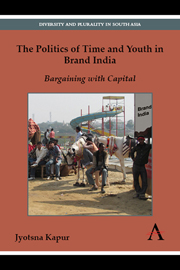Book contents
- Frontmatter
- Dedication
- Contents
- Acknowledgments
- Introduction: After Me the Flood
- Chapter 1 Brand India's Biggest Sale: The Cultural Politics and Political Economy of India's “Global Generation”
- Chapter 2 Arrested Development and the Making of a Neoliberal State
- Chapter 3 For Some Dreams a Lifetime is Not Enough: The Rasa Aesthetic and the Everyday in Neoliberalism
- Chapter 4 An “Arranged Love” Marriage: India's Neoliberal Turn and the Bollywood Wedding Culture Industry
- Chapter 5 Ek Haseenah Thi (There Once Was a Maiden): The Vanishing Middle Class and Other Neoliberal Thrills
- Conclusion
- Notes
- References
- Index
Chapter 4 - An “Arranged Love” Marriage: India's Neoliberal Turn and the Bollywood Wedding Culture Industry
Published online by Cambridge University Press: 05 March 2014
- Frontmatter
- Dedication
- Contents
- Acknowledgments
- Introduction: After Me the Flood
- Chapter 1 Brand India's Biggest Sale: The Cultural Politics and Political Economy of India's “Global Generation”
- Chapter 2 Arrested Development and the Making of a Neoliberal State
- Chapter 3 For Some Dreams a Lifetime is Not Enough: The Rasa Aesthetic and the Everyday in Neoliberalism
- Chapter 4 An “Arranged Love” Marriage: India's Neoliberal Turn and the Bollywood Wedding Culture Industry
- Chapter 5 Ek Haseenah Thi (There Once Was a Maiden): The Vanishing Middle Class and Other Neoliberal Thrills
- Conclusion
- Notes
- References
- Index
Summary
Whether made in India or abroad, the big fat Bollywood wedding has become a trademark attraction of all that is Bollywood. A trend started by films such as Hum Apke Hain Kaun…! (Can You Name Our Relationship?) (Sooraj Barjatya 1994) and Dilwale Dulhaniya Le Jayenge (Those with Heart Will Take the Bride) (Aditya Chopra 1995), it has crossed over internationally via films such as, Mira Nair's Monsoon Wedding (2001) and Gurinder Chadha's Bride and Prejudice (2004). In turn, real weddings have become increasingly spectacular, egged on by a newly emerged wedding industry in which the Bollywood form has seamlessly merged. Celebrity weddings add fuel to the fire. Reportedly, British model Elizabeth Hurely's diamond encrusted wedding sari cost £4,000 while the tiny gold balls dangling from leading film star Aishwarya Rai's wedding sari were — in the tradition of the maharajas — distributed to the “poor.” In a perceptive review of Mira Nair's Namesake (2007), Stuart Klawans (2007) commended Nair for directing the film, particularly the wedding scenes, with “the instincts of a hostess” — a comparison which indicates the extent to which staging a wedding as a cinematic attraction has blurred into staging its real counterpart as a film-in-the-making.
How might we understand this reinvention of tradition at the very moment India is supposed to have broken from history to emerge as a power in the global economy, this assertion of ethnic identity in the midst of an unprecedented presence of global brands and the “discovery” of Indian cinema, specifically Bollywood, as a national icon at the height of its global fame?
- Type
- Chapter
- Information
- The Politics of Time and Youth in Brand IndiaBargaining with Capital, pp. 93 - 106Publisher: Anthem PressPrint publication year: 2013



